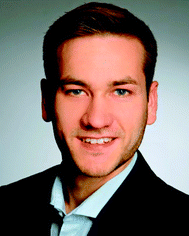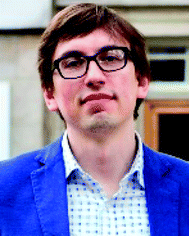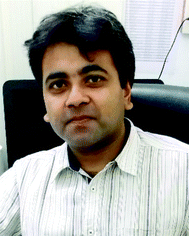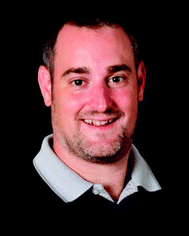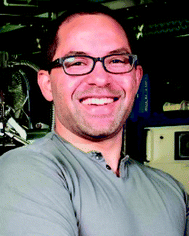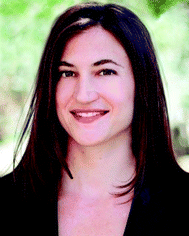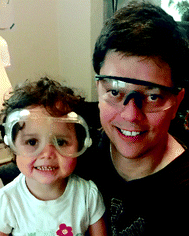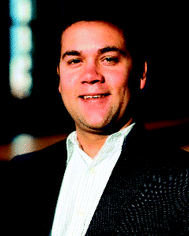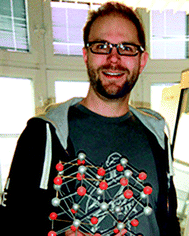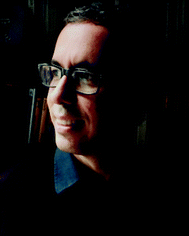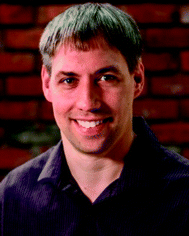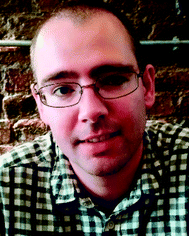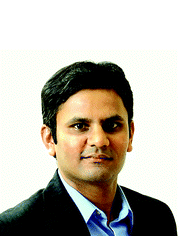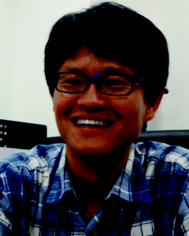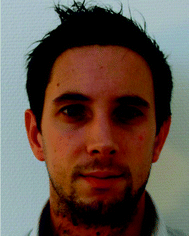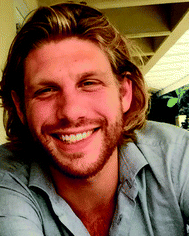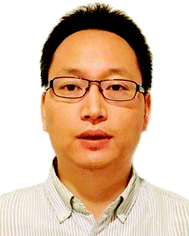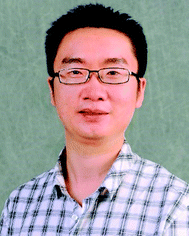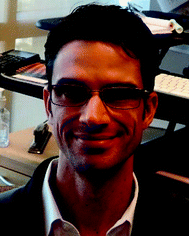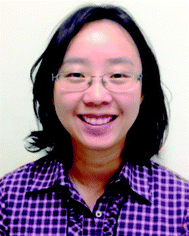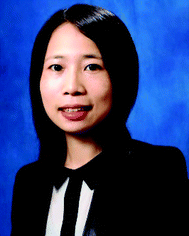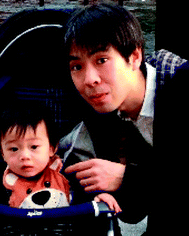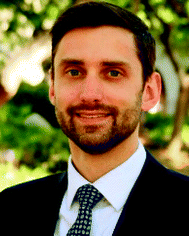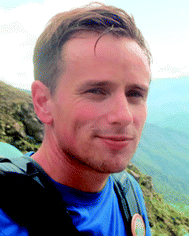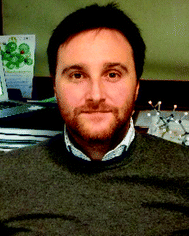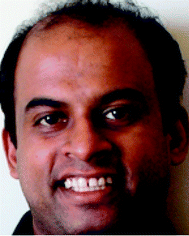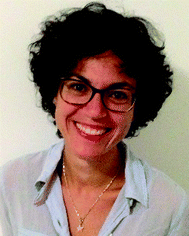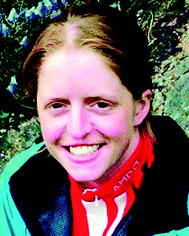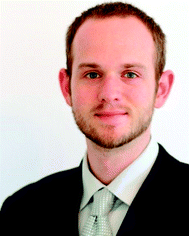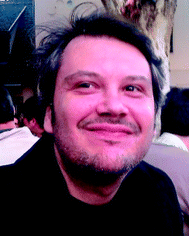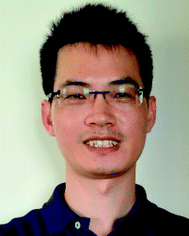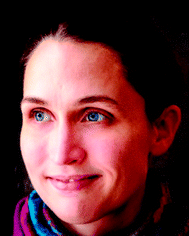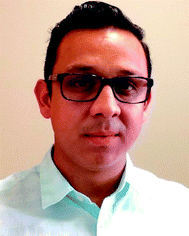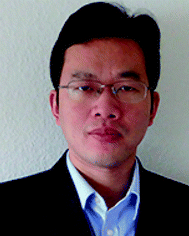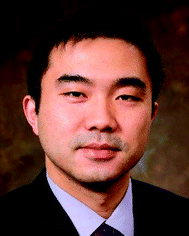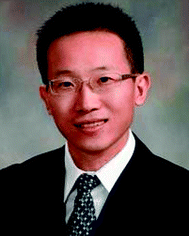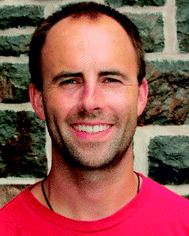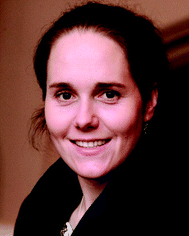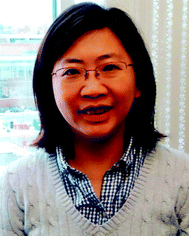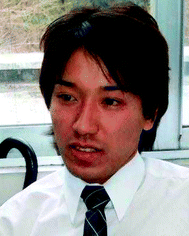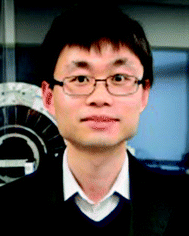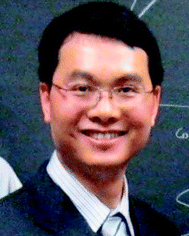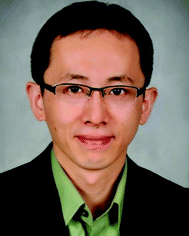DOI:
10.1039/C7TA90116J
(Profile)
J. Mater. Chem. A, 2017,
5, 11384-11395
Profile: Emerging Investigators 2017
Steve Albrecht is a Young Investigator Group leader for perovskite based multi-junction photovoltaics at the Helmholtz Center Berlin for Materials and Energy. He received a Ph.D. in physics from the University of Potsdam for his work on understanding the photon to collected charge conversion in organic solar cells. For his Ph.D. he was awarded the Carl-Ramsauer Prize and the Young Researcher Prize of the Berlin Physical Society and the Leibniz-Kolleg Potsdam, respectively. After his Ph.D., he started a postdoc at the Helmholtz-Center Berlin where he developed, together with collaborators from EPFL, the first monolithic perovskite/silicon heterojunction tandem solar cell. His recently established group focuses on the further development of highly efficient perovskite based multi-junction devices.
Artem Bakulin is developing and applying new ultrafast spectroscopy methods for the characterisation of organic electronic materials and nanostructures. He obtained his B.Sc. and M.Sc. degrees in physics from Lomonosov Moscow State University and his Ph.D. from the University of Groningen working on multidimensional IR spectroscopy of water and organic semiconductors. After this, he was awarded a number of postdoctoral fellowships which he carried out at Cavendish Laboratory, University of Cambridge and the AMOLF institute, Amsterdam. In 2016 he started a new research group in the Department of Chemistry, Imperial College London, focusing on IR optical control techniques and vibronic coupling phenomena in soft conductive materials.
Sayan Bhattacharyya was born in Kolkata where he did his B.Sc. at Maulana Azad College. After obtaining his M.Sc. degree from the University of Kalyani, West Bengal, he completed his Ph.D. with Professor N. S. Gajbhiye at the Indian Institute of Technology, Kanpur, India in 2006. After his postdoctoral research with Professor (Emeritus) Aharon Gedanken at Bar-Ilan University, Israel and Professor Yury Gogotsi at Drexel University, USA he joined IISER Kolkata in April 2010 where he is now an Associate Professor of the Department of Chemical Sciences and Head of the Centre for Advanced Functional Materials. He is a Materials Chemist interested in photovoltaics, catalysis for energy, magnetism and drug delivery. A combination of wet-chemical synthesis and self-assembly of smart nanomaterials, structure–property correlation and device applications are used to attain these research goals.
Pedro H. C. Camargo is an Associate Professor at University of Sao Paulo, Brazil. He obtained his B.S. and M.Sc. degrees in Chemistry from Federal University of Paraná in 2003 and 2005, respectively. In 2005, he was a recipient of a Fulbright/CAPES Fellowship to pursue his Ph.D. in the US. He obtained his Ph.D. from Washington University in Saint Louis in 2009, where he worked in the group of Professor Younan Xia. He was hired as an Assistant Professor at the University of São Paulo in 2011 and was promoted to Associate Professor in 2015. He serves as an Editor of the
Journal of Materials Science and as an Associate Editor of the
Journal of the Brazilian Chemical Society. He was one of the Brazilian Delegates in the 3rd Transatlantic Frontiers of Chemistry Symposium in 2013 and received the young scientist award (Hans Viertler Prize) from the Brazilian Chemical Society in 2014. His research interests include the design and synthesis of well-defined nanomaterials with controllable features for applications in plasmonics and catalysis.
Patrick Cappillino began his academic career in the Department of Chemistry and Biochemistry at the University of Massachusetts Dartmouth in 2014 after attaining his Ph.D. in Chemistry at Boston University and completing a postdoc at Sandia National Laboratories. Using his diverse background in inorganic, bioinorganic, and materials chemistry, he has established a research agenda focused on developing active materials for electrical energy storage. Harnessing the power of natural selection in designing batteries is at the heart of his approach to this problem. He was a recipient of the 2015–2016 Electrochemical Society/Toyota Young Investigator Fellowship.
Pavel Cherepanov has started his path to an academic career after receiving Master’s degree in Chemistry in 2006 at the Saint-Petersburg State University, Russia. After graduation, he moved to Toledo, Ohio in the US where he taught undergraduate general, inorganic, and physical chemistry lecture courses at several colleges. In 2012 he joined the research group of Dr Andreeva at the University of Bayreuth, Germany, to pursue his Ph.D. in Chemistry, which he obtained later in 2015. He is currently working as a Research Fellow at the Department of Chemical and Biomolecular Engineering, the University of Melbourne, Australia, where he is conducting research in the areas of electrochemistry and materials science.
Ethan J. Crumlin was born in Massachusetts in 1983 and graduated from Massachusetts Institute of Technology with a B.S. in 2005, a M.S. in 2007 and a Ph.D. in 2012 with Professor Yang Shao-Horn. He then undertook postdoctoral studies at the Advanced Light Source (ALS) at Lawrence Berkeley National Laboratory with Professor Zhi Liu, who is currently at ShanghaiTech University in China. In early 2014, he became a Principal Investigator at ALS, where he focuses on
in situ and
operando Ambient Pressure X-ray Photoelectron Spectroscopy (APXPS). His research interests span the fields of electrochemical energy conversion and storage, interfaces, catalysis, environmental chemistry, corrosion, and scientific innovation.
Tanja Cuk obtained her Ph.D. in Applied Physics at Stanford University in 2007, after which she started her postdoctoral work at the University of California, Berkeley on a Miller Postdoctoral Fellowship. In 2010, after completing her fellowship, she went on to become an Assistant Professor in the Department of Chemistry at Berkeley, and a Faculty Scientist for the Chemical Sciences Division at the Lawrence Berkeley National Laboratory. Her research focuses on the fundamental mechanisms involved in converting charge into fuel at solid–liquid interfaces, for which she applies multiple time-resolved spectroscopies. She is supported by the Condensed Phase Interfaces and Materials Science program within the Department of Energy. She received the Air Force Office of Research Young Investigator Award and the Bakar Fellowship.
Julio M. D’Arcy is an Assistant Professor of Materials Chemistry at Washington University in St. Louis. He completed his Chemistry Ph.D. studies at UCLA in 2012, working for Professor Richard B. Kaner, where he specialized in conducting polymer chemistry and thin film deposition technologies for optoelectronic applications. He continued his studies as a postdoctoral fellow (2012–2014) at MIT working for Professor Paula T. Hammond at the Koch Institute where he worked on layer-by-layer assembly, drug delivery technologies, and energy storage applications. His group is focused on material synthesis of nanoarchitectures of redox active materials emphasizing the rational design of soft organic electronics for energy storage technologies. The D’Arcy lab also explores additive manufacturing for engineering surfaces and structures that advance soft material processing and applications.
Neil Dasgupta is an Assistant Professor in the Department of Mechanical Engineering at the University of Michigan. He earned his Ph.D. from Stanford University in 2011. Prior to joining the University of Michigan in 2014, he was a postdoctoral fellow at the University of California, Berkeley. He is the recipient of an AFOSR Young Investigator Award (YIP), a 3M Non-Tenured Faculty Award, the SME Outstanding Young Manufacturing Engineer Award, the AVS Paul Holloway Young Investigator Award, and the American Society of Mechanical Engineers (ASME) Pi Tau Sigma Gold Metal. His research focuses on the intersection of nanotechnology, energy conversion, and manufacturing.
Alexey Ganin received his M.Sc. from the Lomonosov Moscow State University, Russia in Materials Chemistry and his Ph.D. in Inorganic Chemistry at the Max-Planck Institute for Solid State Research, Germany. He worked as a postdoctoral researcher in Professor Rosseinsky’s FRS group at the University of Liverpool. In 2013, he joined the University of Glasgow as a Lecturer in Inorganic Chemistry. His current research focuses on using a soft-chemistry approach to the synthesis of solid state materials for environmental and energy applications, including gas storage and electrocatalytic water splitting.
How does material form influence function? How do synthetic choices determine material use? These are the questions that drive the research of James Gardner. By combining synthetic tools and broad approaches to material characterization, he aims to make and use new photoactive and electroactive materials. Each year humanity’s demand for energy and electricity increases. To meet these demands with our limited resources is fundamentally a materials challenge. He is a spectroscopist by training, but was drawn to materials chemistry to address this challenge. His goal is to design simple and durable materials that anyone can prepare, because it is up to all of us to make these solutions a reality.
Ricardo Grau-Crespo studied Physics at the University of Havana, Cuba, and moved to the U.K. to obtain a Ph.D. (2006) in computational materials science in the groups of Professor Nora de Leeuw and Professor Richard Catlow, FRS. After postdoctoral and fixed-term lectureship appointments at University College London, he took up a lectureship at the University of Reading, UK in 2013, where he leads a research group focused on the computational modelling of materials with applications in energy (photocatalytic and thermoelectric devices) and catalysis.
Ken Hanson received a B.S. in Chemistry from Saint Cloud State University (2005). He went on to earn a Ph.D. under the mentorship of Mark E. Thompson at the University of Southern California (2010) and then worked as a postdoctoral scholar for Thomas J. Meyer at the University of North Carolina at Chapel Hill (2010–2013). His independent research career at Florida State University began in 2013 where his group works on the design, synthesis and characterization of photoactive molecules/materials for use in solar energy conversion, photocatalysis, and other applications.
Tom Hasell is a Royal Society University Research Fellow in the School of Chemistry at the University of Liverpool. He is a graduate of the University of Nottingham, where he stayed to complete a Ph.D. under the supervision of Steve Howdle (Chemistry) and Paul Brown (Engineering), while collaborating closely with Martyn Poliakof and Ed Lester, as well as taking up placements in the USA (Eric Beckman, University of Pittsburg) and Japan (Satoshi Yoda, NIAST). He then joined Andy Cooper’s group at the University of Liverpool in 2008, initially as a postdoctoral researcher and later as a research coordinator. During this time he played a significant role in the development of porous organic cages. He has worked in a wide range of areas across materials science, including synthesis, supercritical processing, polymer science, nanocomposites and porous materials. Tom was awarded the European Young Chemist of the year award in 2014.
Hui Huang is currently a Professor at the College of Materials Science and Opto-electronic Engineering, University of Chinese Academy of Sciences (UCAS). He obtained his BA in Chemistry from Beijing Normal University, his MA from the Institute of Chemistry, Chinese Academy of Sciences and his Ph.D. from Dartmouth College under the supervision of Professor Russell P. Hughes in 2008. From 2008 to 2010 he carried out his postdoctoral training with Professor Tobin J. Marks and Professor Antonio Facchetti at Northwestern University. In 2010, he joined the Renewable Energy Group at the Research Center of ConocoPhillips as a research scientist. He moved back to China to join UCAS as a member of the Hundred Talents Program in 2013. He has published approximately 40 peer-reviewed papers and holds over 10 patents. His research interests include organic/polymeric semiconductors for photovoltaics, thin-film transistors, photodetectors, and biosensors.
Prashant Jain grew up in Bombay, where he completed his undergraduate education at the Institute of Chemical Technology. He obtained his PhD in Physical Chemistry working with M. A. El-Sayed at Georgia Tech, following which he was a postdoctoral fellow at Harvard. After a Miller Fellowship at UC Berkeley he joined the UIUC faculty, where he is the I. C. Gunsalus Scholar and an Associate Professor (eff. Aug 2017) in the Department of Chemistry and the Materials Research Lab. Prof. Jain’s laboratory is advancing the understanding and control of light-matter interactions on the nanoscale, and the use of nanoscale imaging for the elucidation of chemical transformations and catalytic reactions in complex solid – areas in which his work has been cited nearly 15,000 times. Prof. Jain is also the lead developer of nanoDDSCAT, a toolkit for simulation-based learning and the design of light-matter interactions and plasmonic phenomena.
John Keith is an R. K. Mellon Faculty Fellow in Energy, a tenure-track Assistant Professor, at the University of Pittsburgh’s Department of Chemical and Petroleum Energy and is affiliated with Pitt’s Center for Energy. He obtained a B.A. from Wesleyan University and a Ph.D. from Caltech. He was then an Alexander von Humboldt postdoctoral fellow at the University of Ulm and then an Associate Research Scholar at Princeton University before starting at Pitt in September 2013. His group studies atomic scale chemical reaction mechanisms with computational chemistry to elucidate design principles for improved catalysts and materials. When time permits, he plays the cello and is an avid chamber musician.
Youngsik Kim is an Associate Professor in the School of Energy and Chemical Engineering at the Ulsan National Institute of Science & Technology (UNIST), Korea. He received his Ph.D. (2006, advisor: Professor Steve W. Martin) in Materials Science and Engineering from Iowa State University. After that, he joined Professor John B. Goodenough’s group at The University of Texas at Austin as a post-doctoral fellow. His current research is focused on ceramic and composite electrolytes for rechargeable batteries and low cost and sustainable electrochemical energy storage systems for large-scale ESS applications. He is also working as the CEO of an energy solution company, 4TOONE Corporation.
Benjamin Le Droumaguet graduated from the Université de Rennes, France, where he obtained an M.Sc. degree in molecular chemistry in 2004. Then, he completed a Ph.D. thesis at the Université de Genève, Switzerland in 2008 in the field of polymer–protein bioconjugates under the supervision of Dr Kelly Velonia. He came back to France for a post-doctoral fellowship in the research group of Professor Patrick Couvreur, working on the synthesis of functionalized biodegradable polymeric nanoparticles for active targeting. In 2011, he was appointed Associate Professor at the Université Paris-Est Créteil, France, where he is currently leading his research directed towards advanced macromolecular engineering, materials surface chemistry and hybrid porous polymer-based materials with emphasis on supported catalysis.
Tomas Leijtens obtained his Ph.D. from Oxford University in 2014 under the supervision of Professor Henry J. Snaith, where his work focused on understanding charge transport mechanisms and stability of dye sensitized and metal halide perovskite solar cells. From 2013–2015 he was a Marie Curie (ITN) fellow at the Center for Nano Science and Technology in Milan, where he investigated photophysical processes and degradation in metal halide perovskite semiconductors under the supervision of Dr Annamaria Petrozza. He currently holds a postdoctoral Marie Curie Fellowship as a researcher at Stanford University working with Professor Michael McGehee. His present research is focused on the development of small bandgap perovskite absorbers and their use in all-perovskite tandem solar cells, though studying the stability of metal halide perovskite absorbers is dear to his heart. In his free time, Tomas enjoys playing the guitar and nerding out on science jokes.
Kevin C. Leonard is an Assistant Professor in the Chemical and Petroleum Engineering Department at the University of Kansas. He received his Ph.D. in Materials Science from The University of Wisconsin – Madison in 2011 (Advisor: Marc A. Anderson), and subsequently was a postdoctoral fellow in Professor Allen J. Bard’s group at the University of Texas at Austin. He joined the faculty at the University of Kansas in 2013, and his current research interests include heterogeneous electrocatalysis, electrocatalytic nanomaterials and catalytic imaging
via scanning electrochemical microscopy.
Chang-Zhi Li joined the faculty position at Department of Polymer Science and Engineering of Zhejiang University in 2015, through the selection of Young 1000 Talents Global Recruitment Program of China. Before that, he conducted research at the University of Tokyo (2007–2010) and the University of Washington (2010–2015). He received B.S. and Ph.D. degrees in Chemistry from Fudan University, with joint training at the Shanghai Institute of Organic Chemistry, CAS. His research explores the boundaries and fundamentals of photon-to-electron conversion with cost-effective materials.
Fanxing Li is an Associate Professor at the Chemical and Biomolecular Engineering Department at North Carolina State University. He received his B.S. and M.S. degrees in Chemical Engineering from Tsinghua University in 2001 and 2004 respectively. He received his Ph.D. at the Ohio State University in 2009. He has won numerous awards including the Best Ph.D. in Particle Technology Award, the U.S. National Science Foundation CAREER Award, the SABIC Young Professional Award, the NC State Sigma Xi Faculty Research Award and was named as an NC State University Faculty Scholar.
Darren J. Lipomi earned his undergraduate degree in chemistry from Boston University in 2005 and his Ph.D. at Harvard University in 2010 with Professor George M. Whitesides. From 2010–2012, he was a postdoctoral fellow in the laboratory of Professor Zhenan Bao at Stanford University. He began his independent position at UC San Diego in 2012 and is now an Associate Professor in the Department of Nano-Engineering. He is the recipient of the AFOSR Young Investigator Award and the NIH Director’s New Innovator Award.
Jian Liu obtained his Ph.D. degree in Physical Chemistry from the Dalian Institute of Chemical Physics, Chinese Academy of Science in 2008. Subsequently, he moved to Australia and worked as Postdoctoral Research Fellow at AIBN, the University of Queensland. He started as a Lecturer at Curtin University in 2013 and was promoted to Senior Lecturer in 2014. He has published >120 peer reviewed journal articles with over 6900 citations (
H-index of 43). He was honoured with a prestigious UQ Foundation Research Excellence Award and an Australian Postdoctoral Fellowship. His current research interests are nanoreactor design, green chemical process, and the utilization of CO
2.
Xinhui Lu is an Assistant Professor in the Department of Physics at the Chinese University of Hong Kong. She received her B.S. degree in Physics from Nanjing University in 2004 and her Ph.D. degree in Physics from Yale University in 2010. After that, she served as a postdoctoral research associate at the Condensed Matter Physics and Materials Science Department of Brookhaven National Laboratory, USA for two years before joining the Department of Physics at CUHK. Her research interests lie in experimental soft condensed matter physics, including the morphology and device performance of semiconducting organic materials, the bulk and surface structure of functional thin films, and synchrotron X-ray scattering techniques.
Yi-Chun Lu is an Assistant Professor in the Department of Mechanical and Automation Engineering at The Chinese University of Hong Kong (CUHK). She received her B.S. degree from the National Tsing Hua University and Ph.D. degree in Materials Science & Engineering from the Massachusetts Institute of Technology in 2012 (working with Professor Yang Shao-Horn). After her graduate studies, she worked as a Postdoctoral Fellow in the Department of Chemistry at the Technische Universität München (working with Professor Hubert Gasteiger). She is the recipient of the Hong Kong Research Grants Council Early Career Award (2014) and the CUHK University Education Award (2016). Her research group has dynamic interests and has made extensive efforts in the fields of electrode and electrolyte design for Li-ion, metal–air and metal sulfur batteries, redox-active solution chemistry for redox-flow batteries, electrocatalysts and electrode design for fuel cells/electrolyzers, and probing interfacial phenomena governing electrochemical energy conversion and storage processes.
Kazuhiko Maeda received a B.Sc. from the Tokyo University of Science (2003), an M.Sc. from the Tokyo Institute of Technology (2005) and a Ph.D. from The University of Tokyo (2007) under the supervision of Professor Kazunari Domen. From 2008–2009, he worked as a postdoctoral fellow at Pennsylvania State University with Professor Thomas E. Mallouk. In 2009, he joined The University of Tokyo as an Assistant Professor. Moving to the Tokyo Institute of Technology in 2012, he was promoted to Associate Professor. From 2010–2014, he was a research fellow of the PRESTO/JST program. His research interests include water splitting and CO
2 reduction using semiconductor photocatalyst materials.
Matthew McDowell started at Georgia Tech in 2015 as an Assistant Professor with a joint appointment in the George W. Woodruff School of Mechanical Engineering and the School of Materials Science and Engineering. Prior to this appointment, he was a postdoctoral scholar in the Division of Chemistry and Chemical Engineering at the California Institute of Technology. He received his Ph.D. in 2013 from the Department of Materials Science and Engineering at Stanford University. His research is focused on developing improved materials for electrochemical energy systems by understanding dynamic processes and interfaces. He has published 50 scientific papers, and he has received a variety of awards, including the Materials Research Society Graduate Student Gold Medal and the AFOSR Young Investigator Award.
Graham Newton obtained his Ph.D. in 2008 from the University of Glasgow, under the guidance of Lee (Professor Lee Cronin) before moving to the University of Tsukuba, Japan, to work with Professor Hiroki Oshio on a JSPS Postdoctoral Fellowship. He was made Assistant Professor at the University of Tsukuba in 2011, before returning to the UK and the University of Nottingham in 2015. His research is focused on the development of redox- and photo-active advanced molecular materials for applications in a range of technologies.
Michele Pavone earned his Ph.D. in Chemical Sciences (2007) from the University of Naples Federico II, Italy, where he is now Associate Professor of Physical Chemistry. Experiences abroad include several short-term research positions as a visiting scholar at the Ecole Nationale Supérieure de Chimie de Paris (ENSCP) in France (2003–2004), one year as a visiting research graduate student at Princeton University (2005–2006), and a two-year postdoctoral fellowship at Princeton University (2010–2012). His research activity focuses on the application of cutting-edge computational tools to designing heterogeneous functional materials for energy conversion processes, including electrodes for fuel cells, solar cells, and batteries. In the last five years, he has been national coordinator of two Italian projects on the rational design of nano-heterogeneous materials for solar energy conversion (FIRB Futuro in Ricerca) and on the development of effective first-principles methods to study hybrid organic–inorganic interfaces (PRIN). He has been awarded the Carla Roetti Medal 2016 for best young researcher under 40 by the Division of Chemical Theory and Computation of the Italian Chemical Society.
Sebastian C. Peter received his B.Sc. (1998) and M.Sc. (2000) degrees in chemistry from St. Thomas College, Calicut University, M.Tech. (2002) in industrial catalysis from the Cochin University of Science and Technology, and his Ph.D. in chemistry from the University of Münster, Germany (Professor Rainer Pottgen, 2006). He was a postdoctoral fellow at the Max Plank Institute for Chemical Physics of Solids, Dresden, Germany (Professor Yuri Grin, 2006–07) and Northwestern University, USA (Professor Mercouri Kanatzidis, 2007–10). He joined as Ramanujan faculty fellow at the New Chemistry Unit, Jawaharlal Nehru Centre for Advanced Scientific Research, Bangalore in 2010. His broad research interests include the development of solid-state inorganic materials for various applications ranging from renewable energy (fuel cell) to condensed matter physics (magnetism and transport properties). He has more than 120 peer reviewed publications and four patents. He was invited to and attended around 50 national and international conferences. He is a member of the American Chemical Society, Royal Society of Chemistry, ASM international, Chemical Research Society of India, Material Research Society of India, International Union of Crystallography, Indian National Young Academy of Science, and Society for Material Chemistry of India. Recently, a team led by him launched a start-up company named BREATHE Applied Sciences Pvt. Ltd. in 2016 with the mission of reducing waste CO
2 into useful chemicals and fuels. BREATHE entered into the semifinal of the NRG COSIA carbon XPRIZE worth $20M for the efficient reduction of CO
2 originating from the coal power generation sector. He has been selected as an emerging investigator in various fields by ACS and IOP. He received the Materials Research Society of India (MRSI) medal in 2014 and was selected as a member of the Indian National Young Academic of Sciences (INYAS) in 2016. He is the executive committee member in the Catalysis Research of India, Doctoral Advisory Committee member of Poornaprajna Institute of Scientific Research (PPISR), Bangalore, Editorial member of the
Journal of Solid State Chemistry and
Advances in Chemistry and expert committee member of the Technology Mission Division, Department of Science and Technology, India.
Annamaria Petrozza was awarded an M.Sc. in Electronic Engineering at Ecole Supèrieure d’Electricité (Paris, France) in 2003 and at Politecnico of Milan in 2004 under the T.I.M.E. (Top Industrial Manager in Europe) program. In 2009, she received her Ph.D. in Physics from the University of Cambridge (UK) with a thesis on the study of optoelectronic processes at organic and hybrid semiconductor interfaces. From July 2008 to December 2009, she worked as a research scientist at the Sharp Laboratories of Europe, Ltd. on the development of new market competitive solar cell technologies. In January 2010, she moved to the Istituto Italiano di Tecnologia as a Team Leader and, since October 2013, she has held a Tenure Track Scientist position. Her research work mainly aims to shed light on interfacial optoelectronic mechanisms with the goal of improving the efficiency and stability of solution processable semiconductors and devices, with special emphasis on highly efficient third generation solar cells.
Zoe Schnepp is passionate about green chemistry, both in her research and in its potential for changing negative public perceptions of chemistry. With diverse interests in nanotechnology, catalysis, and materials from biomass, she leads a growing group in the School of Chemistry at the University of Birmingham, UK. Prior to her Birmingham Fellowship, she held Postdoctoral Fellowships in the International Center for Young Scientists at the National Institute for Materials Science in Japan and the Max Planck Institute for Colloids and Interfaces in Germany. She received her Ph.D. from the University of Bristol. In her spare time, she enjoys triathlon, mountain biking and playing hockey.
Morgan Stefik obtained a B.E. in Materials Engineering from Cal Poly SLO in 2005, an M.S. and Ph.D. in Materials Science from Cornell University in 2009 and 2010, respectively. He was then a postdoctoral researcher at École Polytechnique Fédérale de Lausanne from 2011–2013. He joined the University of South Carolina in 2013 as an Assistant Professor in the Department of Chemistry and Biochemistry and is the founding director of the South Carolina SAXS Collaborative. His research focuses on nanomaterials chemistry with an emphasis on self-assembly techniques and atomic layer deposition. He is a serial hobbyist and most recently is building and flying acrobatic quadcopters.
Thomas Stergiopoulos is a Lecturer at the Department of Chemistry, at Aristotle University of Thessaloniki (Greece), working on perovskite optoelectronics. He just finished a two year Marie Curie IEF fellowship working at the Clarendon Laboratory at University of Oxford, with Professor Henry J. Snaith on perovskite solar cells. Before that, he took his Ph.D. in Physical Chemistry, working at the National Centre for Scientific Research Demokritos (Greece), while being a visiting researcher for one year at the CNRS-Laboratoire Interfaces et Systemes Electrochimiques (LISE) in Paris (France). Besides doing science and raising two lovely young boys, Thomas is scouting players for his favourite basketball team.
From left to right: Aaron Martinez, Angela Fioretti, Adele Tamboli, and Eric Toberer.
Adele Tamboli is a scientist at the National Renewable Energy Lab in Golden, Colorado. Her research focuses on hybrid multijunction photovoltaics, which combine distinct classes of materials into high efficiency devices. These architectures enable the use of new materials as alternatives to the conventional III–V materials, as well as integration with silicon bottom cells. Adele received her Ph.D. in Materials from the University of California, Santa Barbara, where she worked on GaN/InGaN nanocavity lasers, and did a postdoc at Caltech, where she studied III–V/Si microwire arrays for photovoltaics and solar fuels. She has a B.S. in Physics from Harvey Mudd College. She has a joint appointment with Colorado School of Mines, where she co-supervises graduate students, including Aaron Martinez and Angela Fioretti. Aaron’s Ph.D. research focuses on both bulk synthesis and epitaxial growth of ZnSiP2, with the goal of integration with silicon. Angela’s Ph.D. research focuses on the development of ZnSnN2 photovoltaics using combinatorial methods. Her students are co-advised by Eric Toberer, an Assistant Professor at Colorado School of Mines with a joint appointment at NREL, whose research focuses on designing complex semiconductors for optoelectronic and thermoelectric applications.
Yuxin Tang obtained his B.S. and M.S. degrees at Nanjing University of Aeronautics and Astronautics in 2006 and 2008 respectively, and received his Ph.D. in 2012 from Nanyang Technological University, Singapore. Currently, he is a research fellow with Professor Xiaodong Chen at the same university. His research interest is the rational design of advanced functional materials for energy conversion and storage, including lithium-ion batteries and solar-driven photocatalytic applications.
Francesca M. Toma is a Staff Scientist in the Chemical Sciences Division at the Lawrence Berkeley National Lab. She earned her M.S. from Padua University in 2006, and her Ph.D. in Biophysics from the International School of Advanced Studies in Italy in 2009. She then moved to the University of California Santa Barbara as a Marie Curie Researcher in 2011, and to the University of California Berkeley in 2013. Her main research interests lie in the synthesis and advanced characterization of integrated materials systems, to understand the structure–activity relationships that enable the development of novel functional architectures for solar fuel production. In 2016, she was the recipient of the Alfredo di Braccio awarded by the Accademia Nazionale dei Lincei to young chemists, for her prolific, high-quality scientific contribution in different aspects of nanotechnology. When not in the lab, she likes exercising, cooking, and travelling.
Eva Unger is an Assistant Professor at the Department of Chemistry at Lund University (Sweden), an affiliated member of NanoLund. In her Ph.D. studies at Uppsala University (Sweden), she investigated excitonic dye-sensitized solar cells and has been working on dynamic phenomena in hybrid perovskite solar cell devices during operation and materials during their growth and degradation during her postdoctoral research at Stanford University (USA) with a stipend from the Marcus and Amalia Wallenberg Foundation (Sweden). She is currently co-affiliated with Lund University, Sweden and Helmholtz Center Berlin, Germany through an International Career Grant from the Swedish research agency, co-funded by the Marie Sklodowska Curie Actions. She recently became a Young Investigator Group leader, focusing on the scaling and in-process investigations of hybrid materials for printable optoelectronic devices at the Helmholtz Center Berlin for Materials and Energy.
Fernando J. Uribe-Romo was born in Ensenada, Baja California, Mexico. He received a B.Sc. in Chemistry from the Monterrey Institute of Technology and Higher Education (ITESM) in Mexico in 2006 and a Ph.D. in Inorganic Chemistry from the University of California, Los Angeles in 2011 under the supervision of Professor Omar M. Yaghi. He was then a postdoctoral associate at Cornell University with Professor William R. Dichtel. He joined the Chemistry Department at the University of Central Florida in the fall of 2013. His research focuses on the synthesis of two- and three-dimensional self-assembled polymeric materials, in particular crystalline metal–organic and covalent-organic frameworks, for their applications in energy conversion, photocatalysis, charge transport, and optical devices.
Ergang Wang is an Associate Professor at the Chalmers University of Technology. He obtained his Ph.D. in Materials Science in South China University of Technology in 2008. After that, he joined Chalmers as a postdoc in 2008–2011. He was appointed as an Assistant Professor in 2012 and Associate Professor in 2016 at Chalmers. The focus of his work is mainly on the design and synthesis of conjugated polymers and graphene-like materials for applications in organic solar cells, organic light-emitting diodes, light-emitting electrochemical cells and OFETs.
Hailiang Wang is an Assistant Professor in the Department of Chemistry at Yale University. He is also a faculty member of the Energy Sciences Institute on Yale West Campus. Prior to joining Yale in 2014, he was a Philomathia Postdoctoral Fellow in the Department of Chemistry at University of California, Berkeley. He received his Ph.D. in chemistry from Stanford University in 2012 and B.S. in chemistry from Peking University in 2007. He is a recipient of the Stanford Graduate Fellowship, the MRS Graduate Student Award (Silver), the ACS Division of Inorganic Chemistry Young Investigator Award, and the IUPAC Young Chemist Award. He is a 2016 Web of Science Highly Cited Researcher. His group studies surface chemistry, solid state chemistry, and materials design for electrochemical energy storage and conversion.
Mingfeng Wang is currently a Nanyang Assistant Professor in the School of Chemical and Biomedical Engineering at Nanyang Technological University, Singapore. He received his B.Sc. degree in Chemistry at Jilin University in 2001, followed by his M.Sc. degree in Polymer Chemistry and Physics under the supervision of Professor Xi Zhang. In 2004, he joined Professor Mitchell A. Winnik’s group at the University of Toronto and obtained his Ph.D. degree in Polymer Chemistry and Materials in 2009. Then he was awarded with a Postdoctoral Fellowship supported by the Natural Sciences and Engineering Research Council of Canada (NSERC), and worked with Professor Fred Wudl on organic photovoltaics at the University of California, Santa Barbara. He joined the School of Chemical and Biomedical Engineering at Nanyang Technological University in 2012. His current research focuses on polymeric materials with bioinspired structures and advanced functions for optoelectronic and biomedical applications.
Gregory Welch obtained his B.Sc. in Chemistry from the University of Calgary in 2003 and worked in the laboratories of Dr Tristam Chivers and Dr Warren Piers. He earned his Ph.D. at the University of Windsor in 2008 under the supervision of Dr Douglas Stephan where he helped to develop the concept of Frustrated Lewis Pairs. He then moved to UC-Santa Barbara, where he studied organic solar cells as a NSERC postdoctoral fellow with Dr Guillermo Bazan. He began a faculty position in 2012 as a Canadian Research Chair at Dalhousie University in Halifax, NS. In 2015 he relocated to the University of Calgary as a Canadian Research Chair in Solar Energy Materials and Devices. His research interests are focused on the design, synthesis, and characterization of organic pi-conjugated materials and their application in organic electronics and catalysis.
Claire White is an Assistant Professor at Princeton University in the Department of Civil & Environmental Engineering and the Andlinger Center for Energy and the Environment. She completed her graduate studies in 2010 at the University of Melbourne supported by an Australian Postgraduate Award from the Australian government. After receiving her Ph.D., she worked as a postdoc at Los Alamos National Laboratory, and was awarded a Director’s Postdoctoral Fellowship to research the atomic structure of low-CO
2 alkali-activated materials. Her research focuses on understanding and optimizing engineering and environmental materials, with an emphasis on controlling the chemical mechanisms responsible for the formation and long-term degradation of low-CO
2 cements. This research spans multiple length and time scales, utilizing advanced synchrotron and neutron-based experimental techniques, and simulation methodologies. She is the recipient of a number of awards including the Outstanding Student Research Prize from the Neutron Scattering Society of America and an NSF CAREER Award.
Hui (Claire) Xiong is an Assistant Professor in the Micron School of Materials Science and Engineering at Boise State University. She received a B.S. in Applied Chemistry and M.S. in Inorganic Chemistry from the East China University of Science and Technology, and a Ph.D. degree in Analytical Chemistry from the University of Pittsburgh. Between 2008–2012, she conducted postdoc work at Harvard University and Argonne National Laboratory where her research involved electrochemical characterization of micro-fabricated cathode materials for micro-solid oxide fuel cells and development of novel nanostructured electrode materials for rechargeable batteries. She received the NSF CAREER Award in 2015. Her current research is focused on design and development of nanoarchitectured and defect-driven electrode materials, the study of electrolyte stability and ion-irradiated electrode materials for energy systems.
Yusuke Yamauchi received his Bachelor’s degree (2003), Master’s degree (2004) and Ph.D. (2007) from the Waseda University, Japan. After receiving his Ph.D., he joined the National Institute for Materials Science (NIMS) to start his own research group. In 2016, he joined the University of Wollongong as a full Professor. He concurrently serves as an honorary group leader of NIMS, a visiting professor at several universities (Tianjin University, King Saud University and Waseda University), and an associate editor of APL Materials published by the American Institute of Physics (AIP). He has published 500 papers in international refereed journals with 20
![[thin space (1/6-em)]](https://www.rsc.org/images/entities/char_2009.gif)
000 citations (
H-index 65). He was selected as one of the Highly-Cited Researchers in Chemistry (Thomson Reuters) in 2016.
Wei Zhang is a Lecturer at the School of Chemistry, University of Lincoln (UK) and an adjunct professor at the Department of Materials Science and Engineering, Hubei University (China), working on perovskite optoelectronics. In his Ph.D. work at Department of Chemical & Biomolecular Engineering, National University of Singapore (Singapore), he studied dye sensitized solar cells. Before that, he obtained his B.Sc. and M.Sc. degrees in chemistry from Hubei University (China). His research interests include high efficiency and low-cost photovoltaics, functional nanomaterials (low dimensional semiconducting metal oxides, plasmonic materials, and photonic crystals), and prospective energy materials for optoelectronic applications.
Yixin Zhao received his B.S. and M.S. degree in Chemistry from Shanghai Jiao Tong University at China in 2002 and 2005. He obtained his Ph.D. from the Case Western Reserve University in 2010, then he worked as a postdoctoral fellow at Pennsylvania State University and the National Renewable Energy Laboratory. His current research interests focus on functional materials for renewable energy and environmental remediation including perovskite solar cells, water splitting, and photocatalysis. He has published more than 70 peer-reviewed papers.
Yu Zhu is an Assistant Professor in the Department of Polymer Science at The University of Akron. He earned his Ph.D. in Physical Chemistry at the University of Cologne, Germany in 2007. After his post-doctoral training in Professor James Tour’s group at Rice University, he joined the Department of Polymer Science at The University of Akron in 2012. His research interests focus on the controlled synthesis and assembly of organic electronic materials and nanomaterials, including conjugated small molecules and polymers, 2D materials, and metal–organic frameworks. His research group is dedicated to advancing the understanding of structure–property relationships of those materials, particularly in the area of energy storage and organic electronics. He is a recipient of the NSF CAREER Award.
|
| This journal is © The Royal Society of Chemistry 2017 |
Click here to see how this site uses Cookies. View our privacy policy here. ![[thin space (1/6-em)]](https://www.rsc.org/images/entities/char_2009.gif) 000 citations (H-index 65). He was selected as one of the Highly-Cited Researchers in Chemistry (Thomson Reuters) in 2016.
000 citations (H-index 65). He was selected as one of the Highly-Cited Researchers in Chemistry (Thomson Reuters) in 2016.

